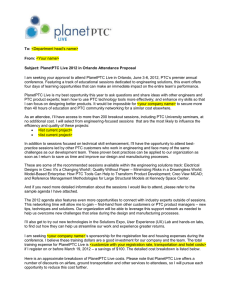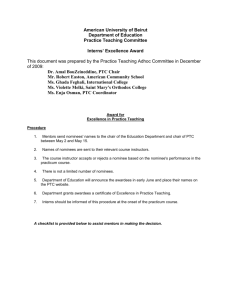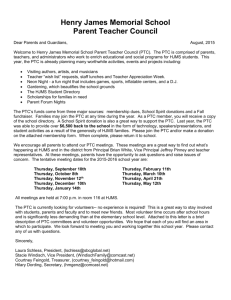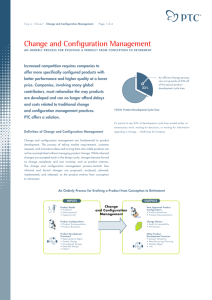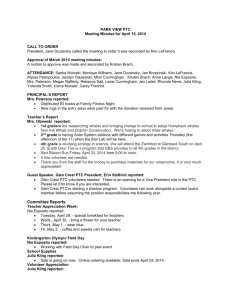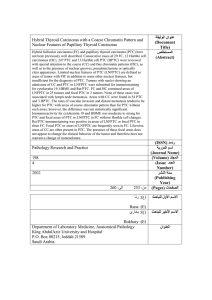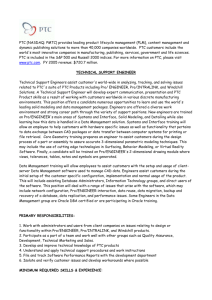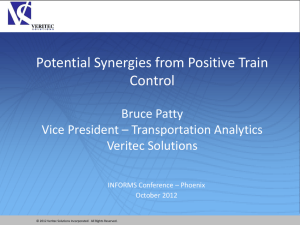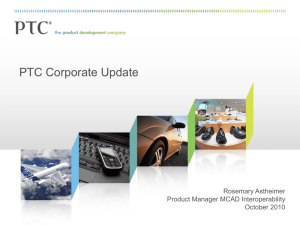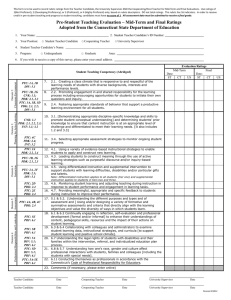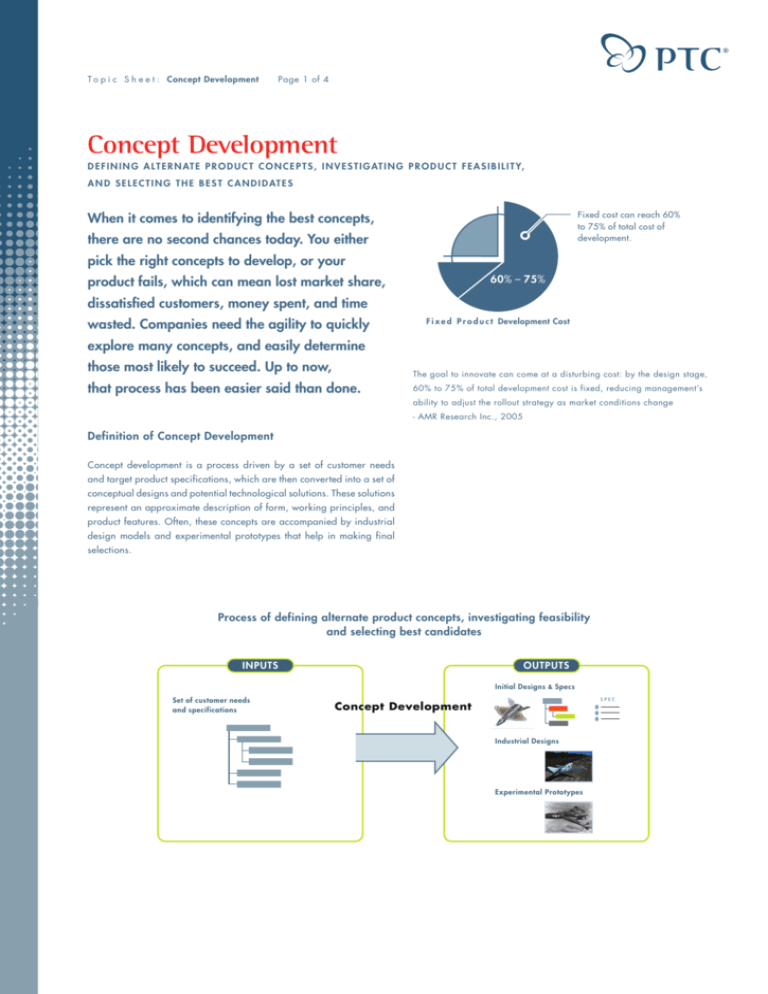
T o p i c S h e e t : Concept Development
Page 1 of 4
Concept Development
D e f i n i n g a lt e r n at e p r o duc t c o n c e p t s , i n v e s t i g at i n g p r o duc t f e a s i b i l i t y,
a n d s e l e c t i n g t h e b e s t c a n d i d at e s
Fixed cost can reach 60%
to 75% of total cost of
development.
When it comes to identifying the best concepts,
there are no second chances today. You either
pick the right concepts to develop, or your
60% – 75%
product fails, which can mean lost market share,
dissatisfied customers, money spent, and time
wasted. Companies need the agility to quickly
F i x e d P r o d u c t Development Cost
explore many concepts, and easily determine
those most likely to succeed. Up to now,
The goal to innovate can come at a disturbing cost: by the design stage,
that process has been easier said than done.
60% to 75% of total development cost is fixed, reducing management’s
ability to adjust the rollout strategy as market conditions change
- AMR Research Inc., 2005
Definition of Concept Development
Concept development is a process driven by a set of customer needs
and target product specifications, which are then converted into a set of
33 %
conceptual designs and potential technological solutions. These solutions
An efficient change process
can cut upwards of 33% off
of the typical product
development cycle time.
represent an approximate description of form, working principles, and
product features. Often, these concepts are accompanied by industrial
design models and experimental prototypes that help in making final
selections.
T O TA L Product Development Cycle Time
Process of defining alternate product concepts, investigating feasibility
and selecting best candidates
INPUTS
OUTPUTS
Initial Designs & Specs
Set of customer needs
and specifications
SPEC
Concept Development
Industrial Designs
Experimental Prototypes
T o p i c S h e e t : Concept Development
Page 2 of 4
Understanding the Need for Concept Development
Benefits of an Optimized Process for Concept
Development
To remain competitive, every company must encourage innovation and
set the stage for the creation of revolutionary ideas. Yet, organizations
Typical benefits of improving the concept development process can
often lack the discipline to embrace a ‘structured’ approach to concept
include:
development. Unfortunately, this deficiency often decreases the likelihood
of a product’s commercial success.
Ensure Thorough Concept Exploration
• Allow methodical research of all potential sources of solution ideas
No doubt, capturing and formalizing concept development, a task
involving many internal stakeholders, is clearly a challenge. For starters,
• Include all organizational stakeholders in consideration
for concept development to ‘get it right the first time,’ the process must
and exploration of wide-ranging solution ideas
reach out to customers to include their voice in concept review and
selection. Complicating matters is the fact that two key objectives of
• Evaluate previously rejected solution concepts
concept development are in perpetual conflict. On one hand, given
tight timeframes, you want a small set of alternatives, so that you may
• Effectively integrate viable fragmented solutions
thoroughly ensure all requirements are met. On the other hand, you gain
valuable insight and innovation by exploring as broad a set of concepts
Increase Product Design Efficiency
as possible. Thus, the dilemma: how do you simultaneously explore
wide-ranging alternatives while ensuring all your requirements are
• Employ best methods and tools to facilitate a productive concept satisfied – and do it all on time?
generation process
• Adopt a formalized, repeatable, and transparent concept
development processes
• Capture and catalog concept ideas to eliminate redundancy
and increase knowledge reuse
• Improve project execution and visibility of team’s progress
Improve Design Collaboration
• Include the voice of customers in concept evaluation to drive
market acceptance upon product launch
• Reduce the potential for wasted effort, by involving all stakeholders to eliminate non-viable concepts early
T o p i c S h e e t : Concept Development
Page 3 of 4
The Solution – PTC’s Product Development System
1
Understand Problem
Requirements
Decompose Problem
Requirements Management
The PTC Product Development System (PDS) delivers all the essential tools
for authoring and managing a complete digital product definition – the
key prerequisite for successful concept development. Digital concept
generation tools enable brainstorming, exploration of design ideas, and
development of product concepts within a single environment. With the
2
PDS, product information surrounding concepts is managed in a single,
Search for Ideas
structured, cross-discipline product data repository that offers timely and
role-based access to a globally dispersed product development team.
Customers can be integrated securely and seamlessly into this collabora-
Complete?
tive environment to ensure concept designs meet requirements.
In general, the Concept Development process can be described by three
Organize & Synthesize
major steps: Problem Definition, Concept Generation, and Concept
Evaluation/Selection.
Develop Concepts
1. Problem Definition. In this step, customer needs and requirements
are interpreted as a set of problems to solve. The problems are broken
down and decomposed into simpler sub-problems. Functional breakdown
3
Analyze Concepts
and problem decompositions are captured and documented in nested
Verification
& Validation
document (object) structures, while online design forums and Web-based
Score Alternatives
meetings record preliminary design decisions.
2. Concept Generation. Solutions are researched for each of the
sub-problems, employing internal and external search procedures. Ideas
Combine & Improve
System Design
Approve?
Approved Concept
Concept Documentation
are further explored using various tools for creating a functioning set of
solutions. Designs are developed using an all-inclusive digital sketching
and modeling tool enables the exploration of design ideas and development of product concepts in a single environment, seamlessly bridging
2D and 3D. Photorealistic renderings enable early collaboration with
colleagues, customers and partners. Solution ideas are then organized,
synthesized, and filtered using classification trees and combination tables
to systematically explore the solution space. Solutions to the sub-problems are then integrated into a total solution.
3. Concept Evaluation/Selection. After multiple concept ideas
are generated, they are analyzed using various techniques including
computer-aided-engineering
and
physical
testing
of
prototypes.
Manufacturability, supply chain capabilities, and other aspects of
product feasibility are also taken into account. Virtual 3D models that
are used to capture product form are simulated to assess their intended
function, quality and manufacturing feasibility. Results are collected and
managed in a central data repository so different alternatives can be
screened and scored to quickly narrow the number and to improve the
concepts. The remaining and improved concepts are then ranked against
the selected reference concept and evaluated by the customer, until the
best set of candidates is chosen to be productized.
Concept development process flow
T o p i c S h e e t : Concept Development
Page 4 of 4
Critical Capabilities
The PTC Product Development System offers the following capabilities,
which support an effective concept development process:
• Intuitive, simple application for creation of initial sketches, layouts and facet modeling tools that turn 2D concept representations
into 3D models
• Integrated environment with 3D detailed authoring tools for
streamlined downstream development of digital product concepts
• Photo-realistic visualization, with real-time rendering, to facilitate design reviews and enhance collaboration
• Web-based environment that provides for secure and seamless integration of distributed concept design teams and external
partners
• Integral, physics-based simulation to explore feasibility of
design concepts
• Single, structured, cross-discipline product data repository for
managing and archiving product concepts
• Timely, role-based access to the latest concept design data
to support a globally dispersed team
PTC offers a wide range of capabilities for rapidly exploring
product concepts
PTC – Uniquely Qualified
An automated and optimized concept development process not only
requires superior technology, it also requires companies to streamline
their day-to-day processes. Just as important, companies need to ensure
that everyone across the organization understands and adopts the new
processes and technology.
After 20 years of deploying process and technology improvements
across thousands of customer sites, PTC Global Services understands
all the components required for companies to achieve their product
development goals. We offer solutions that include the right blend of
When it comes to identifying the
best concepts, there are no
second chances today. You either
pick the right concepts to
develop, or your product fails.
process consulting, system implementation, and education services so
customers realize the most value from their PDS investment. We implement industry best practices that fully leverage PTC technology, so companies take advantage of the technology’s potential while avoiding
costly customizations. Plus, each of our solutions incorporates a unique
training approach that accelerates the adoption of new technology
and processes.
© 2006, Parametric Technology Corporation (PTC). All rights reserved. Information
described herein is furnished for informational use only, is subject to change without notice,
and should not be construed as a guarantee, commitment, condition or offer by PTC. PTC,
the PTC Logo, Pro/ENGINEER, and all PTC product names and logos are trademarks or registered trademarks of PTC and/or its subsidiaries in the United States and in other countries.
All other product or company names are property of their respective owners.
2069-Conceptdev-TS-1 2 0 6

